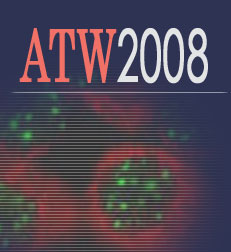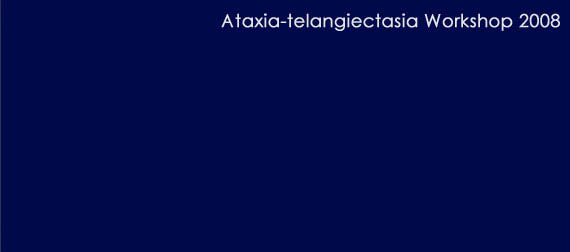The first session of ATW2008 will start at 7 pm after dinner on April 22nd and this workshop will close at noon on 26th.
Chairpersons
Kenshi Komatsu (Kyoto University, Japan)
Shuki Mizutani (Tokyo Medical and Dental University, Japan)
Chief secretary
Junya Kobayashi (Kyoto University, Japan)
Organizing Committee:
Luciana Chessa (Italy), Patrick Concannon (USA), Domenico Delia (Italy), Richard A. Gatti (USA), Penelope A. Jeggo (UK), Kenshi Komatsu (Japan), Martin Lavin (Australia), Susan P. Lees-Miller (Canada), Stephen Meyn (Canada), Shuki Mizutani (Japan), Andre Nussenzweig (USA), Cynthia Rothblum-Oviatt (ATCP), Yossi Shiloh (Israel), Malcolm Taylor (UK)
[Partial list of participants with tentative titles]
Activation of ATM and MRN complex
Tanya Paull (University of Texas at Austin, USA)
Mechanisms of ATM activation
Thanos Halazonetis (University of Geneva, Switzerland)
Mechanisms of sensing DNA damage for ATM and ATR activation
Vincenzo Costanzo (Clare Hall Laboratories, London Research Institute, UK) ???Characterization of novel molecular aspects of the ATM dependent DNA damage response using a cell-free system
Jean Gautier (Columbia University Medical Center, USA)
The MRN-ATM pathway
Zhao-Qi Wang (Leibniz Institute for Age Research, Germany)
The role of NBS1 in VDJ recombination and T cell development
Martin Lavin (Queensland Institute of Medical Research, Australia)
Role of Rad50 in the DNA damage response
Kenshi Komatsu (Kyoto University, Japan)
Roles of NBS1 in responses to genotoxic and non-genotoxic stresses
Shunichi Takeda (Kyoto University, Japan)
Multiple function of the MRN/CtIP complex in DNA damage response
The DNA damage signaling and chromatin response
Yosef Shiloh (Tel Aviv University, Israel)
ATM-mediated signaling in the DNA damage response
Stephen P Jackson (University of Cambridge, UK)
Controlling cellular responses to DNA double-strand breaks
Junjie Chen (Yale University School of Medicine, USA)
BRCA1 and DNA damage responses.
Jiri Lukas (Danish Cancer Society, Denmark)
Dynamic organization of signaling and repair machines at DNA strand breaks
Andre Nussenzweig (NCI, NIH, USA)
DNA repair and checkpoint pathways that prevent propagation of chromosome breaks
Yoichi Taya (National Cancer Center, Japan)
Ser-Pro site of p53 Ser46 is phosphorylated by ATM
Luciana Chessa (University of Rome ?gLa Sapienza?h, Italy)
ATM monitors mitotic spindle integrity
Randal Tibbetts (University of Wisconsin, USA)
CREB/ATFs at the nexus of cyclic AMP and genotoxin-induced pathways
Stephen Meyn (University of Toronto, Canada)
TBA
Tej K. Pandita (Washington University School of Medicine, USA)
MOF is Critical for Embryogenesis and DNA Repair.
Brendan Price (Harvard University, USA)
Acetylation and activation of ATM by the Tip60 acetyltransferase
Oscar Fernandez-Capetillo (Spanish National Cancer Center,Spain)
Investigating the roles of the DNA damage response in vivo
Daniel Durocher (Mount Sinai Hospital, Canada)
Genome-wide RNA interference screen to identify new components of the response to DNA double-strand breaks
Toshiyasu Taniguchi (Fred Hutchinson Cancer Research Center, USA)
TBA
Toru Ouchi (Northwestern University, USA)
Identification of BRCA1-associated BAAT1 as a regulatory protein of ATM
ATR and other DNA repair syndrome/Radiation biology
Stephen West (Cancer Research UK, Clare Hall Laboratories, UK)
The Molecular Mechanism of Aprataxin, the Protein Defective in Ataxia with Oculomotor Apraxia
Roland Kanaar (Erasmus Medical Center, Netherlands)
Genome maintenance through homologous recombination
Karlene A. Cimprich (Stanford University School of Medicine, USA)
Mechanisms for Maintaining Genome Stability at the Replication Fork
Keith W. Caldecott (University of Sussex, UK) ???Single-strand break repair and neurological disease
Maria Jasin (Memorial Sloan-Kettering Cancer Centre, USA)
ATM in meiotic and mitotic double-strand break repair via homologous recombination
Penelope A. Jeggo (University of Sussex, UK)
The interplay between homologous recombination and non-homologous end-joining in DNA double strand break repair
Kum Kum Khanna (Queensland Institute for Medical Research, Australia)
SSB1 and Genome maintenance, a novel player in the DNA damage response pathway
David J. Chen (University of Texas, USA)
Dynamics of DNA-PK complex in response to DNA double-strand breaks
Susan Lees-Miller (University of Calgary, Canada)
The role of DNA-PKcs in Nonhomologous end joining
Shoji Tsuji (Tokyo University, Japan)
TBA
Lee Zou (Massachusetts General Hospital, U.S.A)
Revealing the DNA Structural Determinants for ATM Activation
Kyungjae Myung (NIH, USA)
Human ELG1 functions to repair DNA damage through interactions with PCNA and polymerase h in ATR-dependent fashion
Hisao Masai (Tokyo Metropolitan Institute of Medical Science, Japan)
Regulation of establishment and maintenance of replication fork by Cdc7 kinase
Minoru Takata (Kyoto University, Japan)
FANCI phosphorylation functions as a molecular switch to turn on the Fanconi anemia pathway
Tumorigenesis/Virology / immunodeficiency
Frederick W. Alt (Harvard Medical School, USA)
Role of ATM and the DSB Response in End-joining and Suppression of Translocations
Tasuku Honjo (Kyoto University, Japan)
Somatic hypermutation and class switch recombination
Thomas Crawford (Johns Hopkins University School of Medicine, USA)
TBA
Thilo Doerk (Hanover Medical School, Germany)
Cancer susceptibility alleles in ATM-mediated signalling pathways
Jessamyn Bagley (Harvard Medical School, USA)
ATM in T cell responses
Patrick Concannon (University of Virginia, USA)
ATM, radiation, and the risk of second primary breast cancer
Malcolm Taylor (University of Birmingham, UK)
A study of forty ataxia telangiectasia patients with tumours
Masatoshi Matsuoka (Kyoto University, Japan)
Lentivirus integration and DNA repair
Richard J. Hodes (NIH, USA)
Function of ATM in physiologic recombination events in T and B lymphocytes
Pathogenesis and Translational research/Stem cell
Toshio Suda (Keio University, Japan)
Stem Defects in ATM-Deficient Mice.
Domenico Delia (Fondazione IRCCS Istituto Nazionale Tumori, Italy)
Role of the ATM pathway in human neural stem cell differentiation and survival
Shuji Kishi (Harvard Medical School, USA)
Genetic Models of A-T and Premature Senescence in Zebrafish
Ari Barzilai (Tel Aviv University, Israel)
Molecular analysis of the DNA damage response in mouse cerebellum
Peter McKinnon (St Jude Children?fs Research Hospital, USA)
Responding to DNA strand breaks in the nervous system
Karl Herrup (Case Western Reserve University, USA)
ATM in neurons: cytoplasmic localization and a potential role in vesicle dynamics
Shuki Mizutani (Tokyo Medical and Dental University, Japan)
TBA
Barry Sleckman (Washington University School of Medicine, USA)
ATM Activates a Multi-functional Genetic Program in Response to Physiologic and Pathologic DNA Double Strand Breaks
Richard A. Gatti (UCLA School of Medicine, USA)
TBA
Corry Weemaes (Nijmegen University, Netherlands)
Clinical spectrum of ataxia telangiectasia in adulthood
Maureen Lefton-Greif (Johns Hopkins University School of Medicine, USA)
Feeding / Swallowing Problems and Their Implications for Patients with Ataxia-Telangiectasia
Sharon McGrath-Morrow (Johns Hopkins University School of Medicine, USA)
Lung Function and Pulmonary Concerns in Adolescents with Ataxia Telangiectasia.

